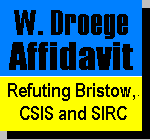 The
Heritage Front Affair
The
Heritage Front AffairA report to the Solicitor General of Canada
 The
Heritage Front Affair
The
Heritage Front Affair
The information in this report covers several groups and individuals
associated with the extremist right in Canada. To give context to the persons,
groups and events which are described in the other sections of this report,
we have provided a brief overview of how the leadership and members in
the extreme right promote themselves and their ideas under different names
at different times.
We have not tried to be all-inclusive, nor have we tried to offer the reader
an in-depth examination of how extremist groups have evolved. There are
several texts on the market which do this.[1]
Rather, we offer a short "primer" on the antecedents of
the Heritage Front.
Differences do exist between the extremist groups, largely as a function
of how drastic their remedies are for the problems they perceive to exist
in Canadian society. Common to most of the organizations listed below are
their doctrines, whether clandestine, to attract a wider range of support
or, as is increasingly the case, blatant. Their fundamental agreement is
the conviction that whites (aryans) are an endangered species. These beliefs lead, in turn,
to their attitudes which are: anti-Semitic; anti-non whites; anti-immigration/refugee;
anti-democratic; pro-free speech for racist or anti-Semitic ideas; anti-human
rights; and anti-gay. The members tend to drift from one group to another
and then back again in order to realize their xenophobic aims.
whites (aryans) are an endangered species. These beliefs lead, in turn,
to their attitudes which are: anti-Semitic; anti-non whites; anti-immigration/refugee;
anti-democratic; pro-free speech for racist or anti-Semitic ideas; anti-human
rights; and anti-gay. The members tend to drift from one group to another
and then back again in order to realize their xenophobic aims.
Hate literature, racially motivated crimes, and the rise of political
organizations dedicated to a racist ideology are not new phenomena in Canada.
The Ku Klux Klan, for example, took root in Western Canada in the 1920's.
Canadian Fascist and Nazi movements replaced the short lived Ku Klux Klan
in the 1930s and 1940s. Adrien Arcand's Parti National Social Chretien
[2] advocated that Fascism was the only solution
to the "Jewish invention" of our system of liberal democracy.
Arcand promoted Hitler as the saviour of Christianity.[3]
In the period immediately after the Second World War, racism and
anti-Semitism lost their popularity, but the concepts did not die. Arcand,
for example, ran for federal election in 1949 under the National Unity
Party, an extension of his previous organization.
Two of the more recent seminal groups in this country's radical right were
the Canadian Nazi Party and the Edmund Burke Society. Together they "paved
the way for the rush of right-wing organizations that would march across
the nation in the decades to follow."[4]
In 1965, John Beattie formed the Canadian Nazi Party, which marked the
re-emergence of the neo-nazi political movement in Canada. The group promoted
Hitler and his ideas, prompting no fewer than a "dozen organizations
to spring up to do battle" with it.[5]
Violent confrontations took place and Beattie was eventually sent to prison
for six months for public mischief.
In 1967 the Canadian Nazi Party became the National Socialist Party, again
with Beattie as its national leader. He set up a recorded telephone message
line "stating among other things that blacks were being manipulated
by Jew-communists."[6]
Paul Fromm and Donald Andrews (Vilim Zlomislic) founded the Edmund
Burke Society in 1967. This Toronto-based organization, described as "fringe
right" by Stanley Barrett, covered the gamut of right-wing issues,
although anti-communism started out as the main focus of its attack. The
Society openly opposed "immigration, sex education, welfare, homosexuality,
abortion, big government and Pierre Trudeau."[7]
Their activities included the distribution of a newsletter and battles
with left-wing groups.[8] But in practice,
"their group was little more than a repository for mean-spirited
racists and anti-Semites."[9] Eventually,
some members of the Society became involved in criminal activities including
vandalism, arson and assault.
There was an explosion of right-wing activity in the 1970's and 1980's.
According to Barrett, in 1987 there were close to 130 different groups
functioning in the right wing milieu.[10]
As the author stated, the radical right started out as anti-communists,
but over time, they adopted the politics of racial purity and anti-Semitism.[11]
In February 1972, the Edmund Burke Society became the Western Guard.
Under Donald Andrews, the group's orientation changed from countering communism
to vilifying Jews and non-whites. Those who were non-violent, such as Paul
Fromm, left the Western Guard,[12] and were
replaced by overtly racist members who pushed the group towards a more
aggressive white supremacist and anti-Semitic platform.[13]
In 1973, the Western Guard set up a telephone hateline. Six years later,
the line was "cut" by the Canadian Human Rights Commission
which deemed it discriminatory. The same scenario would be repeated two
decades later, this time in regard to the Heritage Front. Andrews had the
dubious  distinction
of being the first person in Canada charged with wilfully promoting hatred.[14]
In 1975, he faced offenses ranging from plotting arson, possession of weapons
and explosives, and mischief. He was sentenced to two years in jail for
conspiring to bomb a visiting Israeli soccer team. Consequently, the leadership
fell to John Ross Taylor in 1976.
distinction
of being the first person in Canada charged with wilfully promoting hatred.[14]
In 1975, he faced offenses ranging from plotting arson, possession of weapons
and explosives, and mischief. He was sentenced to two years in jail for
conspiring to bomb a visiting Israeli soccer team. Consequently, the leadership
fell to John Ross Taylor in 1976.
Ordered by the Courts to stay away from the Western Guard, on his release
in 1977 Andrews created the Nationalist Party of Canada. The Party's activities
and beliefs were similar to those of the Western Guard. The Party appealed
to the basest instincts of those who joined it: anti-immigrant, anti-gay,
fearful of the disappearance of the white race around the world, anti-affirmative
action, anti-Black, and anti-Jewish. In the mid-1980s the Toronto membership
varied between 150 to 300 persons depending up on who was cited.[15]
Paul Fromm went on to form two new fringe right wing organizations:
Citizens for Foreign Aid Reform (C-FAR) and the Canadian Association for
Free Expression (CAFE). C-FAR attacks Canadian foreign aid and immigration
policies. CAFE, founded in 1981, focuses on issues of free speech. The
individuals and groups defended by this organization are generally from
the radical right, and include such Holocaust deniers as Ernst Zundel,
Jim Keegstra and Malcolm Ross.
In Alberta, a white supremacist umbrella group started to take shape in
the early 1980s. In 1984, Terry Long's Aryan Nations (AN) finally received
official recognition from the American leader of the Church of Jesus Christ
Christian - Aryan Nations.[16] The AN advocates
violence to establish an all Aryan state and is vehemently anti-Semitic
and anti-Black. Associated with the AN was another militant group called
the Aryan Resistance Movement (ARM). ARM, based in British Columbia, supports
the extreme right-wing philosophy of the superiority of the white race
and violently opposes those considered to be "non-white".
ARM's Nazi publications are the "amongst the most venomous in the
country."[17]
 Wolfgang
Droege was a member of the Western Guard in the mid-seventies before switching
his efforts to the Ku Klux Klan (KKK) in 1979. Droege, along with
Wolfgang
Droege was a member of the Western Guard in the mid-seventies before switching
his efforts to the Ku Klux Klan (KKK) in 1979. Droege, along with Alexander McQuirter, was instrumental in increasing the membership in the
group to an estimated 2,500 in 1980.[18] At
this time, the KKK and Don Andrews' Nationalist Party of Canada formed
a temporary merger. But Droege was convicted and imprisoned in the United
States for his part in the plot to overthrow the Government of
Alexander McQuirter, was instrumental in increasing the membership in the
group to an estimated 2,500 in 1980.[18] At
this time, the KKK and Don Andrews' Nationalist Party of Canada formed
a temporary merger. But Droege was convicted and imprisoned in the United
States for his part in the plot to overthrow the Government of  Dominica
and on several drug and weapons charges. McQuirter quit the Klan at the
same time and, soon afterwards, was facing conspiracy to murder charges.
In their absence, the KKK slowly disappeared.[19]
Dominica
and on several drug and weapons charges. McQuirter quit the Klan at the
same time and, soon afterwards, was facing conspiracy to murder charges.
In their absence, the KKK slowly disappeared.[19]
The early 1990's belong to the Heritage Front and racist skinheads.
Disgruntled members of the Nationalist Party formed the Heritage Front
in the Fall of 1989. In a few short years, the Heritage Front became the
most prominent white supremacist group in Canada. The Heritage Front also
became embroiled in a series of legal actions by the Canadian Human Rights
Commission and the Federal Court involving their telephone "hateline".
Currently, a number of HF members are facing assault, robbery, contempt
of court and other charges.
The Heritage Front worked closely with other groups such as the Church
of the Creator (COTC), which was led by George Burdi He was said to be
the second in command of the Heritage Front. The militant and action-oriented
COTC disbanded in 1993 with the leader making racist recordings in the
wake of arrests and criminal charges laid against Eric Fischer and Burdi.
The members remain active, nonetheless.
COTC followers have joined the Heritage Front and the Northern Hammerskins,
a racist skinhead group which is potentially more violent than its predecessor.
Other neo-nazi skinhead groups such as the Aryan Resistance Movement and
the Alberta-based Final Solution Skinheads are organizing and finding a place in the extreme-right network in Canada.[20]
and finding a place in the extreme-right network in Canada.[20]
To avoid prosecution and violation of bail or release conditions,
many white supremacists in North America are re-organizing under the concept
of "individual leadership". Members of extremist groups
are conducting "business as usual" but they are trying
to do so as individuals. The trend is away from identifiable groups whose
leaders can be charged for the criminal acts of those they influence.
1 See Stanley R. Barrett,"Is God a
Racist. The Right Wing in Canada", Toronto: University of Toronto
Press, 1987; Warren Kinsella, "Unholy Alliances", Toronto: Lester
Publishing Limited, 1992; Warren Kinsella, "Web of Hate. Inside Canada's
Far Right Network", Toronto: Harper Collins, 1994.
2 The Party expanded into Ontario as the National Christian Party
of Canada and was renamed in the post-war period as the National Unity
Party.
3 Barrett, 1987, p.22.
4 Barrett, p.41.
5 Barrett, p.45.
6 Barrett, p.47.
7 Kinsella, 1994, p.207.
8 Stanley Barrett speculated that the group might have been started
by police agencies seeking to undermine the left wing and to engage in
agent provocateur activity (p.70).
9 Kinsella, 1992, p. 103.
10 Barrett, Appendix.
11 Barrett, p.30.
12 Fromm spoke at the Western Guard's founding meeting, attended
by a leading American Ku Klux Klan leader. Barrett, p. 75.
13 Kinsella, 1994, p. 208.
14 Kinsella, 1994, p.239.
15 Barrett, p.106.
16 Barrett, p.172.
17 Kinsella, 1994, p.53.
18 Kinsella, 1994, p.217.
19 Kinsella, 1994, p. 220.
20 Kinsella, 1994, pp. 266-281.